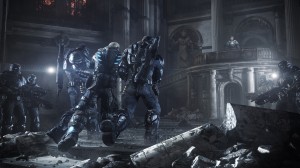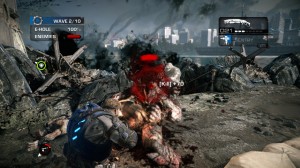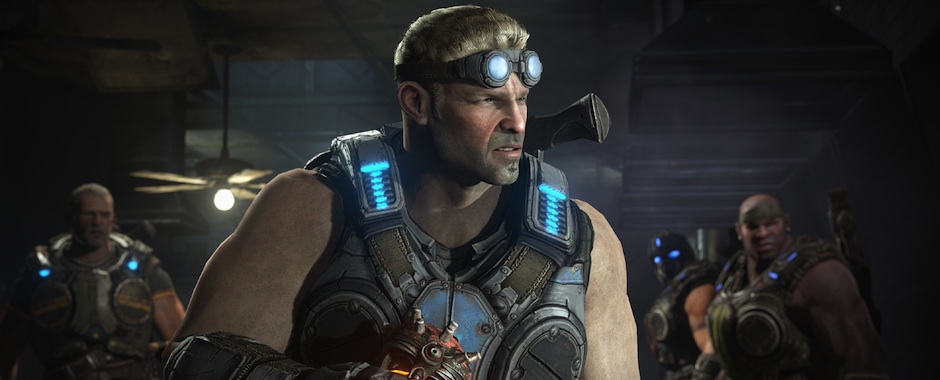 This year isn’t looking good for Xbox 360 exclusives. While Microsoft’s aging console is entering the twilight of its life cycle with no shortage of high-quality multiplatform options for Xbox gamers, the fact remains, they’re sharing them all with the PlayStation, Nintendo and/or PC communities. Fortunately, Xbox 360 players have at least one exclusive to call their own for 2013, standing as a lone effort to try and coax them away from the immense aftermarket offerings of last year’s Xbox 360 opus, Halo 4. This lone exclusive is Gears of War: Judgment, a prequel game to the best-selling Gears of War trilogy taking place fifteen years before the events of the original Gears of War game, and a long overdue attempt to try and mix up the series’ typical gameplay progression.
This year isn’t looking good for Xbox 360 exclusives. While Microsoft’s aging console is entering the twilight of its life cycle with no shortage of high-quality multiplatform options for Xbox gamers, the fact remains, they’re sharing them all with the PlayStation, Nintendo and/or PC communities. Fortunately, Xbox 360 players have at least one exclusive to call their own for 2013, standing as a lone effort to try and coax them away from the immense aftermarket offerings of last year’s Xbox 360 opus, Halo 4. This lone exclusive is Gears of War: Judgment, a prequel game to the best-selling Gears of War trilogy taking place fifteen years before the events of the original Gears of War game, and a long overdue attempt to try and mix up the series’ typical gameplay progression.
If you’re unfamiliar with Gears of War, allow us to bring you up to speed; It’s a series of co-operative third-person shooters that takes place on the fictional Earth-like planet, Sera, where humanity is on the losing end of a brutal war against the subterranean alien species, The Locust Horde. Standing as the humans’ last line of defense, the soldiers of the COG (Coalition of Ordered Governments), enact a series of desperate plans to turn the tide before humankind is fully eradicated. Previous games unfolded from the perspective of the COG’s Delta Squad, led by disgraced sergeant, Marcus Fenix. Judgment however tries to mix things up out of the gate by instead placing you in control of a new quartet of soldiers, Kilo Squad, and, what do you know, they’re led by the defiant smirk of one Lieutenant Damon Baird, future Delta Squad engineer, and fan-favourite character.
As players start the main story campaign, they’re immediately met with an opening cutscene of Kilo Squad being led to a court marshal in chains. Tried for some mysterious crime, each member of the squad steps forward to present their testimony of the events leading up to their arrest. Each ‘Act’ of the campaign thus unfolds from the perspective of a different member of Kilo Squad, consisting of Baird, Private Augustus ‘Cole Train’ Cole (another returning fan-favourite from Delta Squad), and two all-new characters, journalist-turned-soldier, Private Sofia Hendrick, and former COG enemy, Private Garron Paduk. It’s a very clever narrative device that quickly compensates for the vague and often muddled storytelling that dragged down the prior Gears of War trilogy, even if it does quickly become a bit predictable, with players no doubt easily able to piece together events to come, even by the end of the first Act.
 Fortunately, the gameplay in Judgment is sound as ever! As with Gears of War 3, you can opt to play the campaign solo, taking control of each Kilo Squad member as they present their testimony, or you can bring up to three other friends to experience the story alongside you via Xbox Live, each controlling a different Kilo Squad soldier for the duration of the game. As usual, the emphasis on co-op makes Judgment’s campaign at its best when you bring company along, but the intense cover-based firefights are still plenty appealing if you’re going it alone with the A.I. too.
Fortunately, the gameplay in Judgment is sound as ever! As with Gears of War 3, you can opt to play the campaign solo, taking control of each Kilo Squad member as they present their testimony, or you can bring up to three other friends to experience the story alongside you via Xbox Live, each controlling a different Kilo Squad soldier for the duration of the game. As usual, the emphasis on co-op makes Judgment’s campaign at its best when you bring company along, but the intense cover-based firefights are still plenty appealing if you’re going it alone with the A.I. too.
The gameplay will remain largely familiar to Gears of War veterans, as they proceed through each shooting section, using the chest-high scenery to protect themselves from Locust bullets and explosives, returning fire and trying to eradicate all of the enemy forces, which allows them to proceed to the next section of the story. Many of the weapons and Locust strains will be familiar to fans, from the chainsaw-equipped Lancer assault rifles to the vicious Gnasher shotguns in the case of the former, to the standard Drone soldiers, heavyweight explosive-firing Boomers, and aggressive melee-based Wretches in the case of the latter. Of course, Judgment makes some new additions on both counts as well. Some new weapons include the Booshka grenade launcher, rifle-esque Breechshot, and, our personal favourite, the Tripwire Crossbow, which allows players to lay explosive ‘surprises’ for ambushing Locust whenever Kilo needs to defend an objective. There’s also one new Locust strain to battle against, that being the Rager, which needs to be killed with an immediate headshot, lest it mutate into a much faster and stronger version of itself after soaking up a few bullets anywhere else.
The new weapons and enemies aren’t at all the key innovation in Judgment however. The key innovation comes in the form of an overhauled gameplay style that chunks each firefight of the campaign into ‘sections’. After completing a section, players are graded on their combat performance, detailing things like how many headshots they scored, how many times they were downed by enemy fire and needed to be revived by a teammate, how many ribbons they earned (which are given for specialty kills like killing multiple Locust with a single explosion, or slicing up three Locust in a row with the Lancer’s chainsaw bayonet), and how much they stayed in cover. Depending on how well they did, they’ll earn Stars, which vary in prestige depending on the difficulty level they’re playing on (Bronze for Casual, Silver for Normal, Gold for Hardcore, and Onyx for Insane), which also nets them more valuable EXP to upgrade the rank of their multiplayer avatar.
 With this newfound emphasis on chasing high scores, it’s not unfair to think of Judgment as a more arcade-style shooter compared to its predecessors, and one that seems to more passionately lend itself to Xbox Live play. There’s much more of a focus on action and thrills during the firefights, whereas the prior trilogy was more about playing defensively and staying in cover when possible. Judgment however pushes players to get into the thick of the fight, and goes even further to that end by more often equipping the Locust with weapons like mortars, ink grenades and other such tools that actively force Kilo out of cover frequently. While some players will no doubt embrace the more exciting direction, others may feel that Judgment is dumbing down the combat fundamentals, being more about cheap thrills than actually playing smartly.
With this newfound emphasis on chasing high scores, it’s not unfair to think of Judgment as a more arcade-style shooter compared to its predecessors, and one that seems to more passionately lend itself to Xbox Live play. There’s much more of a focus on action and thrills during the firefights, whereas the prior trilogy was more about playing defensively and staying in cover when possible. Judgment however pushes players to get into the thick of the fight, and goes even further to that end by more often equipping the Locust with weapons like mortars, ink grenades and other such tools that actively force Kilo out of cover frequently. While some players will no doubt embrace the more exciting direction, others may feel that Judgment is dumbing down the combat fundamentals, being more about cheap thrills than actually playing smartly.
Fortunately, the optional Declassified Missions go a long way toward keeping the strategy intact in Judgment. Within each section is a glowing Crimson Omen symbol, the stamp of the Gears of War franchise, which you can investigate to add to the testimony of whichever Kilo Squad member is currently on the stand. If you’d rather have a more traditional Gears of War experience of just gunning down Locust, you can ignore these optional challenges entirely, but fans looking for a serious test of their skills will find them well worth activating.
When you activate a Declassified Mission, the testifying Kilo Squad member will bring up adverse conditions to emphasize Kilo Squad’s dire circumstances. These can include things like having to fight the Locust with reduced visibility, being forced to use weapons that put you at a disadvantage, having your ammo taken away, completing the section under a time limit, and a few other tough tasks. The benefit of undertaking Declassified Missions is that Stars accumulate faster if you successfully complete each section, so score-chasers will definitely want to seek them out. Some can be quite trying, especially on Insane difficulty, but it’s extremely satisfying to come out on top even when the odds are against you, especially when co-ordinating strategies online with your buddies! Making these further exciting is that Judgment never presents the same Locust foes twice in any section playthrough, making it a different experience even when reloading checkpoints. On one attempt, you may find Wretches attacking you with the typical Drones, while in another, they may employ Boomers instead, constantly keeping players on their toes, which is fantastic!
 The only serious problem with the campaign comes in when you’re playing solo, because the A.I. of your unmanned squad mates is pretty awful. Sure, they’re smart enough to revive you most of the time (even if they‘re still content to watch you bleed out every now and again), but they can‘t aim very well, they frequently run in front of your own bullets and block your shots, they’re extremely reckless, and on higher difficulties especially, you’ll be babysitting them much more often than relying on them. If you plan to beat the game on Insane difficulty while also doing every Declassified Mission, you’re practically forced to play with a full team of other human players, since the A.I. is so maddeningly unhelpful!
The only serious problem with the campaign comes in when you’re playing solo, because the A.I. of your unmanned squad mates is pretty awful. Sure, they’re smart enough to revive you most of the time (even if they‘re still content to watch you bleed out every now and again), but they can‘t aim very well, they frequently run in front of your own bullets and block your shots, they’re extremely reckless, and on higher difficulties especially, you’ll be babysitting them much more often than relying on them. If you plan to beat the game on Insane difficulty while also doing every Declassified Mission, you’re practically forced to play with a full team of other human players, since the A.I. is so maddeningly unhelpful!
Fortunately, the combination of graded firefights and Declassified Missions make Judgment’s campaign feel very fresh and exciting, lousy A.I. and all, finally pulling the series out of the gameplay rut it had settled into by Gears of War 3. They also make Judgment’s campaign ten times more replayable, along with the randomized Locust opposition, motivating players to keep playing the campaign missions indefinitely, beyond just looking for collectible COG Tags and trying to conquer higher difficulties. It’s a very smart new system that makes Judgment the most engaging Gears of War game since the original!
It will take about six to eight hours to complete a single campaign playthrough, depending on your difficulty, and you can unlock a bonus campaign called ‘Aftermath’ that details a lost mission from Gears of War 3, should you earn enough Stars. Unfortunately, Aftermath feels like a tacked-on extra, since it’s missing all of the fun new additions to Judgment’s gameplay, and, frankly, it’s kind of boring. Fans will probably go through it once to see the minor story events, then never touch it again.
Of course, when you tire of the campaign, you can enter the Xbox Live arena to take part in Judgment’s extensive multiplayer suite! The usual play modes of Team Deathmatch and Domination are present from prior Gears of War games, and while the widely adored Horde Mode and Beast Mode are disappointingly absent from Judgment, elements of them are rolled into some ‘upgraded’ play modes, namely the new Survival and Overrun modes.
 There’s also finally a Free-for-All playlist in a Gears of War game, allowing players to forget all of that teamwork malarkey and just focus on killing each other. Free-for-All is great for players who either don’t have headsets, or don’t care to deal with talking to the many disagreeable players on Xbox Live, and it can be fun in short bursts, though it also seems to suffer from some balance issues. Just about every online player is wielding a Gnasher, since it’s the only weapon that’s of any use beyond the heavy weapons littered around each map, which only unbalance the game even more, since any player carrying them is unstoppable, so long as they don’t get snuck up on. Hopefully a patch fixes this in the near future.
There’s also finally a Free-for-All playlist in a Gears of War game, allowing players to forget all of that teamwork malarkey and just focus on killing each other. Free-for-All is great for players who either don’t have headsets, or don’t care to deal with talking to the many disagreeable players on Xbox Live, and it can be fun in short bursts, though it also seems to suffer from some balance issues. Just about every online player is wielding a Gnasher, since it’s the only weapon that’s of any use beyond the heavy weapons littered around each map, which only unbalance the game even more, since any player carrying them is unstoppable, so long as they don’t get snuck up on. Hopefully a patch fixes this in the near future.
If any of the new modes will draw players’ attention, it’s Overrun, which feels like the most inspired of the lot. Mashing Horde Mode and Beast Mode together essentially, Overrun divides ten players into two teams of five, one being the COG, and the other being the Locust. The COG soldiers pick from four ‘classes’, Team Fortress-style, including Engineers that repair fortifications, Medics that toss out healing Stim-Gas, Soldiers that drop ammo crates to replenish weapon clips, and Scouts that can throw specialized grenades that highlight enemy locations in red. The Locust team of course choose from various strains to try and get around the COG forces and destroy key objectives, which the COG players do their best to defend for a certain length of time. After every round, the players switch teams to keep things interesting. Overrun is a good multiplayer mode, but it’s best enjoyed with friends over strangers, since it’s very dependent on quickly co-ordinating strategies over your headset. If your luck is bad, it can create landslide scenarios where one team is badly crippled if just one player is being an insubordinate jerk, or doesn’t own a headset at all. Still, it can be a lot of fun when you get a good game going with a fair balance of competent teams.
Survival Mode however, is less interesting. It’s just a ten-wave Overrun variation where up to five players defend an Emergence Hole cover from legions of A.I.-controlled Locust, using the COG classes from Overrun. If you lose two covers, you have to defend one last generator, and if that’s destroyed, the Locust win. It’s basically just Horde Mode with the added burden of protecting an objective, making it a less enjoyable version of Horde Mode, essentially. You can play Survival Mode solo if you wish, but this isn’t all that fun, since, like in the campaign, your A.I.-controlled allies are utter nincompoops, often content to sit and pick their noses in some other location, while Locust ravage your objective, completely undeterred. There’s also no way to issue them commands, and they’ll often outright hinder your own strategy, such as stealing a turret that you were bumped off of and refusing to give it back, not defending you when you’re being attacked, and only throwing out valuable ammo boxes between waves. Even when set to Casual difficulty, it’s almost unfeasible to survive all ten waves without the help of other human players, since the A.I. is so incompetent!
 The multiplayer elements of Judgment are ultimately serviceable for Gears of War fans that like to play on Xbox Live, but it’s also true that the multiplayer suite here is a step down from Gears of War 3. It’s dependent on too many variables to create a good match, and the one playlist that doesn’t require managing all of these variables is plagued by poor gameplay balance, which makes it much more frustrating than it should be. The campaign may be the best Gears of War campaign to date, but it’s disappointing that the package is dragged down by a weak multiplayer element.
The multiplayer elements of Judgment are ultimately serviceable for Gears of War fans that like to play on Xbox Live, but it’s also true that the multiplayer suite here is a step down from Gears of War 3. It’s dependent on too many variables to create a good match, and the one playlist that doesn’t require managing all of these variables is plagued by poor gameplay balance, which makes it much more frustrating than it should be. The campaign may be the best Gears of War campaign to date, but it’s disappointing that the package is dragged down by a weak multiplayer element.
If anything is going to annoy players however, it’s Judgment’s microtransactions. Like Gears of War 3, Microsoft is charging players obscene amounts of real-world money to buy a bunch of weapon and character skins. Sure, you can unlock some of both by accomplishing special feats in the campaign or multiplayer, but most have to be bought, which is very irritating, not to mention greedy! You can also pay real-world money for a certain amount of Double EXP matches, which is money wasted if you end up on the wrong end of a gameplay imbalance online, naturally, or for a VIP Pass, which gives you permanent Double EXP benefits, among a few other boons like early DLC access. While the VIP Pass is certainly a more attractive investment than the skins ($40 for a collection of weapon decorations, Microsoft? Yeah, no thanks!), it’s still nothing you can’t achieve with dedication and skill by just playing the multiplayer normally for a certain amount of time. On top of that, this particular microtransaction creates a gameplay advantage for people who pay extra money to Microsoft, which ruins the integrity of the multiplayer suite to a degree, leaving victory to be bought, not won. Needless to say, that’s not a direction the gaming industry should be taking!
Ultimately, Judgment is flawed to the point of feeling like a lesser product than the trilogy of Gears of War games that preceded it. It’s still a good shooter in the end though, and it’s well worth the attention of fans, particularly for its strong and replayable campaign offering. That said however, as the Xbox 360’s lone high-profile exclusive for 2013, barring any surprise announcements to come anyway, it’s not the show-stopping blockbuster that some Xbox gamers may have hoped for. It certainly won’t tear them away from the much more polished and enjoyable Halo 4 either, especially in regards to Xbox Live play. Those actively seeking a return to Sera, and looking for a unique new challenge for their skills, will still ultimately find their investment satisfied with Judgment. If it’s a console-defining shooter you seek for your Xbox 360 however, then Master Chief still rules the range it seems.

